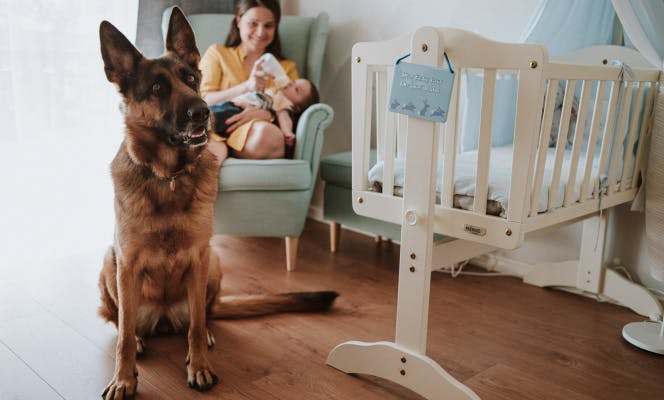Should I Get a Dog? How to Know You’re Ready
By Mawoo Pets · 10 min read
Last updated: November 10th, 2022
There often comes a point in life when all the circumstances feel just right, and it’s time to ask yourself, should I get a dog? Or, if you’re part of a family household, should we get a dog? It’s easy to get caught up in the idea of pet ownership. Dogs are lovable, friendly and just plain fun!
You probably don’t need to hear any more about how great it is to have a dog as a pet, since you’re already here, wondering if it’s time to adopt a puppy. If visions of a fuzzy companion have taken over your brain, read on to find out if you are ready for this adventure.
Things You Should Consider Before Getting a Dog
Adding a puppy or adult dog to your household is as simple as checking out reputable breeders or going to look at homeless animals in the local shelter! Before you adopt, however, it’s very important to ask yourself a few other questions, starting with the following.
Do you have the time for a dog?
Time is what your dog needs the most from you. Even the most low-maintenance dog has daily needs that go beyond snuggling and being cute. Your dog must go outside a few times a day to use the bathroom, and to get some fresh air and exercise. Outside time is also fun for dogs who like to socialize with other dogs, and wag their tails at friendly people you meet along the way.
Are you a busy person with a million things to do every day of the week? If you are, that doesn’t mean you shouldn’t get a dog—it just means you should be very particular about picking the right one. You may prefer an independent dogthat can spend lots of time on its own, or a dog that is highly trainable and sociable so it can accompany you out of the house most days.
Dogs also need regular veterinary care to keep them in good health, which means you will need to spend some of your time at the vet’s clinic. Dogs should see their veterinarian at least once a year for a checkup, as well as anytime they are sick or injured. Pets cannot take human medication such as aspirin to soothe pain, and they can have bad reactions to cheap medications found online or in discount shops, so there’s no way to avoid these trips.
The important thing to keep in mind is why you want a dog in the first place! Having a joyful, loving dog in the family means taking time to return that love and joy. A happy, healthy pet requires time and time management, as well as the basics of food, water and a soft place to sleep.
Are you ready for the commitment?
If everything goes according to plan, your dog should have between 10 and 15 years to spend by your side. Sometimes that length of time can be tough to imagine, so it might help to focus on this: When you move house, start working a new job with different hours, or change anything else about your lifestyle, your dog will still need you! It’s up to you to keep him safe and part of the family no matter what happens in the future.
Imagine yourself next month, next year, and five years from now. Now, imagine your dog by your side at each of those intervals! If that thought makes you happy and excited, you’re going to be a great dog owner.
Think About Your Lifestyle and Plans for the Future

Your life is an exciting collection of possibilities! Tomorrow you might sign up for a university program or move to the mountains of Peru. The question you need to ask yourself before inviting a dog to live with you is, Am I willing to care for my pet no matter where life takes me?
Some dogs, like Pomeranians and Beagles, need lots of attention from their owners. You will have to walk these breeds often but also keep them company most of the day. If you are away from home for most of the day, it’s very important to adopt the sort of dog—say, a French bulldog or a pug—that doesn’t mind being home alone for 6-8 hours.
Exercise needs are another big factor in choosing your ideal dog. Are you the sort of person who loves to be outside, running or hiking or playing on the beach? Make sure your dog loves outdoor adventures, too! Retrievers, border collies, Dalmatians and German shepherds fit the bill nicely in this case.
Mind you, if you live a more sedentary life, look for a dog who will enjoy some good times lounging on the couch with you. Some famous canine couch potatoes include bulldogs, Saint Bernardsand chow chows.
Is your home a suitable environment for a dog?
There’s a bit more to welcoming a dog into your home than just setting out a food and water dish and a blanket. If a dog were to trot into your living space right now, you’d suddenly realize how much stuff is potentially in harms way! Anything on the floor is fair game to a dog, and can easily end up getting chewed on, knocked over or misplaced. This is especially true for puppies.
First things first—if you want to adopt a dog, you should do a little bit of interior redecorating. Anything sitting on a low shelf should probably be placed somewhere the dog won’t be able to reach. Cables and electrical sockets need to be organized and in good working order, properly installed with no breaks.
As for plants, there are two reasons to keep them out of mouth’s reach. The first reason is that they are easily ruined by an enthusiastic pet, and the second reason is that they just might be poisonous. It’s worth doing some research on any houseplants to find out if any are particularly dangerous to dogs, and potentially rehoming any that are.
Can you afford a dog?
There are a few expenses you can count on right away when adopting a dog: Vaccinations, spay or neuter surgery, and basic necessities like food dishes, bedding, and a travel carrier. If you choose a purebred dog from a breeder, the initial expense of adoption will be higher.
The annual cost of dog ownership has been estimated between $2,000 and $3,000, including food and accessories. This estimate includes regular health care appointments for dental cleaning, flea and tick medication and checkups. It also includes pet insurance payments of between $400-$900 per year. Not every owner has pet insurance for their dogs and other animals, but it can help cover costs during a medical emergency.
Is your entire family on board?

There might be members of your family who want a dog just as much as you do. On the other hand, some family members might not be interested, or worse, not even like dogs. For your collective happiness (including that of the doggy in question!) all members of the household need to agree to care for and protect any pet being added to the household.
If you’re having trouble coming together as a family to decide, try to get everyone involved in the adoption process. Do research together. Visit shelters together. Take your friends’ dogs for walks and get to know different sorts of dogs. You’ll likely notice even the most hesitant of family members starting to warm up to the idea of bringing some kind of dog—big or small, fluffy or silky—home with them.
If the problem with getting a dog isn’t so much the dog itself, but the work involved, make a plan with your family. Do your best to make sure nobody has to do all the work of feeding, grooming and walking the dog, so no one person becomes overwhelmed and resentful. And, of course, make sure you do your fair share!
Do Your Research Before Deciding On a Breed

Dogs have been enthusiastically bred by humans for thousands of years, and that means there are about 400 independent breeds of canine. Not to mention hundreds more types of dogs whose background is a mixture of all those recognized breeds!
Different dog breeds don’t just look different from each other, they also can behave differently and have unique needs and health profiles. Small dogs usually have higher energy levels and need a lot more exercise and playtime than their medium or large cousins. Often, the smaller the dog, the more vigilant owners need to be about its health. Even common diseases shared between large and small dogs present differently in the dogs bred to be “miniature” or “teacup.”
Small dog breeds such as Chihuahuas, Pomeranians and Boston terriers are susceptible to poor oral health, including periodontal disease and impacted teeth. This is probably due to the relatively tiny jaw of a small dog, which struggles to contain a full set of teeth. Tracheal collapse, heart disease and bone disorders are also much more common in small dogs than in larger breeds. As for larger dogs, they face potential arthritis, heart problems, and organ issues.
That said, of course, every creature faces health issues and must be cared for properly—even you! Small dogs can literally fit into your life more easily than a big dog, and some of them have longer life expectancy, too. That’s not to say that big dogs can’t feel happy and at home in a small home, or even in an apartment. In fact, there are several breeds of big dogs would love to do just that.
As you do your research on breeds, keep an eye on the energy level, trainability, and potential noise output of each one. Are you looking for a dog who barks when someone approaches the front door? Consider a Chihuahua! Are you not so much a fan of loud dogs? A pug could be your next best friend, and a pretty chill, quiet one, at that.
If you are still thinking, I really want a dog! then we are very happy for you and your dog-to-be! The next step is to make a decision about what type of dog you want, and where it might come from.
If you’d like some help focusing your search, take our Puppy Match Quiz to get some personalized advice. Good luck finding your newest family member!
Related articles
Related puppies for sale
Any questions? Get in touch!
We are here to support you every step of the way. Our concierge service is here daily to answer your questions!
Chat or speak with our team Mon-Sat 9a-9p ET.






















